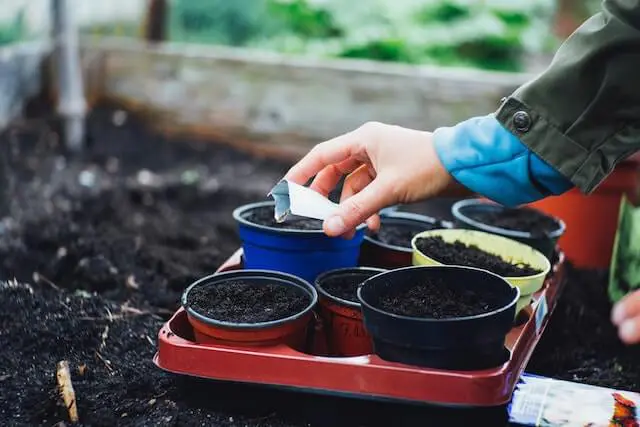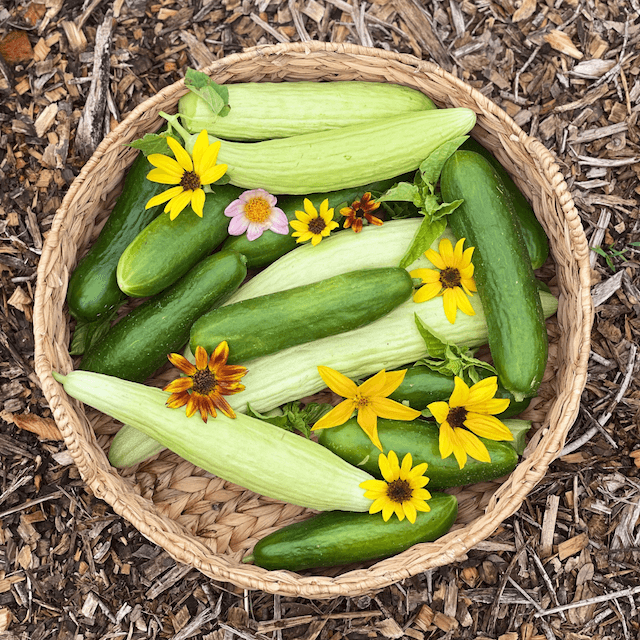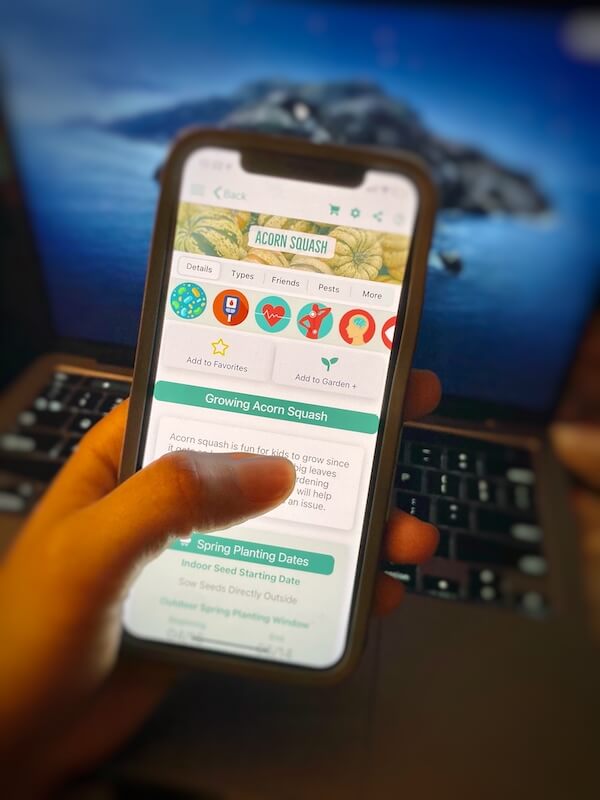Starting seeds indoors: Ultimate Beginner Guide
Our starting seeds indoors beginners guide is the ultimate guide to show you how to grow all the vegetables you want by seed. Be sure to snag yourself a FREE Seed Starting Tracker at the end of this post!
This post may contain affiliate links. As an Amazon Associate, I earn from qualifying purchases. Please read my Disclaimer for more information.
Starting seeds indoors is a powerful thing to do. Seeing your homegrown vegetables grow and eating them is an incredibly rewarding process.

Ultimately, I want you to have the most incredible feeling of feeding your family fresh and delicious vegetables you grew from seeds.
As a nurse, I’m always learning and what helps me retain all the information I need to know is a little thing called acronyms. Therefore, I made up a helpful one to help others on starting vegetable seeds indoors, it is:
Start seeds indoors with The Right T E S T S!
Starting seeds indoors: Table of Contents
Hence, you can always remember the key points to help you start seeds indoors by using the word TESTS, each letter means…
T: TIME
E: ENVIRONMENT
S: SUPPLIES
T: TEMPERATURE
S: STARTER MIX/SOIL/COMPOST
Isn’t that handy?
Now you can start vegetable seeds indoors by remembering this saying: Start seeds indoors with The Right TESTS!
Let’s dig into it more!
Don’t forget your FREE Seed Starting Tracker at the end of this post!

T: TIME- Starting seeds indoors at the right time
First and foremost, it’s important to start seeds when it will benefit them the best. You do not want to start seeds too late or too early, and since everyone’s hardiness, zone/frost date is different (as well as each vegetable they’re growing) the right time varies.
Get your hardiness zone HERE
Grab your last frost date HERE
Additionally, finding the right time to start a certain vegetable from seeds can also be found on the back of each seed packet or a calendar for your specific hardiness zone.
Now that you know the last frost date you can move forward in your seed’s starting process. Working backward to determine the date to sow seeds indoors is how you start vegetable seeds indoors successfully.
Last frost date seed packet example:
Let’s use the seed packet photo below as an example, lets just say my last frost date in April 4th.


Since my last frost date is April 4th and the seed packet says to sow my seeds 4-6 weeks before my last frost date, I highlighted the last four weeks before my last frost date. The yellow dots show the time I have to start my seeds!
Find a calendar you can write on and mark the time frame you have to start your seed indoors and will never forget it!
Note that every seed packet is different, this one is from Baker Creek Heirloom Seed Company. Overall, they will be some directions on how to sow your seeds on the back of a seed packet.
Starting Seeds Indoors Resources
-Plug your zip code HERE to find your seed planting calendar for your specific zone.
-Another great seed planting calendar based on your growing zone HERE
I recommend also you take a peek at my post on how to start a vegetable garden: for beginners, another great resource.

E: ENVIRONMENT – Starting seeds indoors in the right environment
Starting seeds indoors will work if you give your seeds a great environment. This helps them germinate and continue to grow in general.
Depending on what works for you, some gardeners even soak their seeds before planting them. This helps them germinate faster but only works for seeds that have a hard shell.
Best seeds to soak indoors
- peas
- beans
- corn
- pumpkins
- squash
- beets
Most importantly, creating a caring environment is extremely important. Take care of your seedlings in the beginning stages with a little bit more carefulness.
Seedling care tips
–Find a secure location to keep your seed starter plants, not by pets, kids, or chemicals
–Have good air circulation and moisture control where you have your seeds. This prevents damping-off from happening.
-Create a greenhouse effect with a plastic cover or plastic wrap on top of seeds
What is damping off?
This means that there is a fungus that is growing on your new seedlings when their environment is too moist, have a disease in the soil or do not have enough air circulation.
–Watering the bottom of the seedlings is usually in a tray to help the soil stay moist and be sure not to overwater. If you are using a seed starting tray, usually your plastic cells have at least one hole at the bottom to help the plant soak up water from the bottom.
If the soil is moist, then your seedling should be good to go!
- Provide enough sunlight at least 6-8 hours of it. Use a window seal or growing lights to help you out with this.
- Guard seedlings against intense winds or inclement weather
- After your seedlings are bigger try hardening them off before officially transplanting them outside.
What is hardening off plants?
This means helping your plants acclimate to the outdoor environment by taking them outside for about 30 minutes to start then gradually go up to a few hours a day until they are bigger (have at 4-5 leaves in them) to transplant outside.
-The taller your seedlings get, raise your grow light to keep them at least 4 inches above your plants.
Transplanting Seedlings Environment
When you’ve your seeds turn into plants (it can take up to 2 weeks or more), make sure you handle them with care when moving them to their new home, so they can thrive effectively.
Transplanting seedling tips:
- You can sprinkle some mycorrhizae on the roots to decrease the chance of transplant shock.
- Have a good-looking root system forming at the bottom of that plant before transplanting.
- Your plants are at least 4 inches in height before transplanting.
- Your plants have at least 3-5 leaves growing on them.

S: SUPPLIES – Get the right seed starting supplies
Sowing seeds indoors does not have to be difficult or expensive. Getting the right supplies to start sowing seeds indoors is needed to complete the task. Depending on your style of seed starting, not one shoe fits all since a lot of gardeners use various supplies.
What do I need for seed starting?
Basic supplies are listed below.
- Seed Starting tray, Soil Blockers, containers, or peat moss trays: One of the most popular ways is to use seed starting trays. Items like solo cups, cans, or any other type of cups can also be used to sow seeds. Soil blockers are expensive and aren’t necessary, but they are handy if you are growing hundreds or even a thousand seeds.
4. Heating mat: To help your seeds germinate faster and more efficiently.
5. Plant labels– Always label your seeds so you can remember what you planted. DIY labels include painter’s tape, popsicle sticks, or any type of hard cardboard strips of paper.
6. Water can or water wand: Either a house with a sprinkler head on it will do too.
7. Seed dispenser (optional): Helps you sow seeds easier, especially for smaller seeds.
8. Grow light(optional): This is beneficial if you don’t have a greenhouse or a safe area that doesn’t have at least 6-8 hours of sun a day.
9. Mini Greenhouse(optional): You can definitely use any space in your home, but a small green house is a great investment if you plan on growing food often.
10. SEEDS! Look below for more information.
Seeds: What seeds can be started indoors?
The following vegetables can be started indoors for beginners and can be transplanted without problems.
- Broccoli
- peas
- Cabbage
- Cauliflower
- Eggplant
- Squash
- Lettuce
- Onion
- Okra
- tomatillos
- Pepper
- Tomato
- Beets
- Celery
Choosing heirloom seeds, open-pollinated or hybrid seeds are all the different types of seeds you can buy. Check out my post on the 12 Must-know tips: How to choose the right seeds for your garden, it will help you pick seeds for your garden.
what does heirloom vegetable seeds mean?
Seeds that have been passed down through history, families, and communities. These types of seeds are open-pollinated and self-pollinated. Heirloom seeds are highly desirable because of their pure quality and tradition.
what does hybrid vegetable seeds mean?
Made of different types of plants and is manually pollinated for certain characteristics. In short, these seeds are cross-pollinated with other types of plants.
What is an open pollinated seed?
When nature takes control of pollinating with insects, weather, and sometimes the gardener themselves. This helps the plant stay true to its type of plant and will create pure genetics.
You can buy seeds at big box stores like Walmart, Home Depot, Lowes, etc. Popular online seed company’s you can buy from include:
How many seeds do I need to start indoors?
Every gardener’s seed starting needs are different, but for best practice beginner gardeners should start with a small number of seeds. This all depends on the size of your space, and the time you have to give to gardening.
Try out 3 different vegetable seed packets first, and at least 2 varieties types of each vegetable (don’t forget to label!)
This will help you easily keep track of what you liked best. Place at least 2-3 seeds per individual starter tray cell just in case some don’t germinate (you can remove some if more than one starts growing).

T: TEMPERATURE- Know the Best Seed germination temperature
Germination is possible with enough water, oxygen, light, and last but not least…temperature. Starting seeds indoors will grow successfully under certain conditions and how warm temperature is.
Many of your seeds will germinate if they are growing at least 60-75 degrees. Depending on the vegetable some might need a warmer temperature or colder temperature to germinate.
Using a soil temperature guide is a really handy resource if you want to make sure your seeds germinate.
Check out this great Seed germination temperature chart
Fast germination Tips: Should I cover seeds with plastic wrap?
- As stated earlier: It is a good idea to cover your seed starting tray with a plastic top, or clear bag/cover/wrap to create a greenhouse effect. Covers seeds with plastic wrap will help your seeds germinate faster.
- Make the investment and buy a heating pad to place under your seeds until they germinate then you turn off the bottom heat.
- You can place a seed starter tray on top of the refrigerator to get warmth.
- Make sure your seeds always have a light source.

S: STARTER MIX/SOIL- Get the right Starter mix
Furthermore, as long as your seed starting mix feels fluffy you have a great mix!
Looking at the ingredients, you want to see some of the best seed starting mix ingredients. Now you don’t need all of the main ingredients, but if you see a few then you are on the right track.
What is seed starting mix made of?
Below is a list of a few of the main ingredients and their purpose in seed starting mixes.
- Compost– Any type of organic matter is great for retaining nutrients and moisture.
- Mycorrhizae-Helps with water stress, and obtain additional moisture and nutrients.
- Perlite– keeps the soil loose, is well-draining when watering, and aerates the soil.
- Vermiculite-Aerates the soil, and increases the amount of water and nutrients plants get.
- Coconut coir-Helps retain water and moisture.
- Peat moss- helps the soil hold nutrients and can be used as a mulch if lime is added to it.
The best seed starting mix has a fluffy texture to it and when wet, you can squeeze out a little bit of water (not too much) but just enough to know it’s wet. Seeds need a space to grow and not be trapped or can hardly grow if the soil is too stiff.
Go to any local store that sells garden supplies and buy a bag that states it’s an organic seed mix.
You can also make your own seed starting mix, but that requires buying more bags. Compost can also be used but is best to mix in with seed starting mix since it can be too dense. The more organic matter the better.
Learn how to make seed starting mixes HERE if you’re up to it!
Organic Fertilizer
You can also buy organic vegetable fertilizer and use it occasionally after your plants start growing their true leaves (3-4 leaves) and depending on the fertilizing schedule of your vegetables.
Ultimately, buy fertilizer at any store that has N-P-K (nitrogen-phosphorus-potassium) ratio or fish emulsion (be sure to dilute per instructions & beware it is smelly). Don’t get so hung up on the fertilizer ratio as a beginner, but if you are wanting to read about fertilizer, especially for seedlings click HERE.

What is the best way to start seeds indoors?
- Fill whatever container or tray you are growing in with the seed starting mix.
2. Wetting your seed starting mix first is a great tip.
3. Sow your seed by using the right depth the seed packet suggests or the rule of thumb is to sow them 2x the width of the seed.
4. Label each cell row as you place the seed in the soil.
5. Lightly sprinkle starter mix or compost mixture on top to cover the seed.
6. If you’re using a seed starting tray, fill the bottom tray with water.
7. If watering over the seed make sure you do it lightly, so you don’t wash away the seeds.
8. Place a plastic top cover or plastic wrap if you have it
9. Make sure your seeds have a light source.
10. Place seeds in a warm location and place a heat mat under them if you have them.
11. Check on your seeds daily.
12. Water occasionally, if the soil feels moist your seeds are nicely watered, but if it feels dry you may need more water.
(Keep in mind, try to not overwater or underwater.)
For more gardening information, be sure to check out these awesome articles:
7 Easiest Vegetables to Grow for a quick Harvest
FREE Gardening Apps that are Worth Downloading
The Best Seed storage and organization ideas!

Don’t forget to spread the Love❤️ Share this post!







I’ve got my seeds and I’m ready to go! This is great info!
Yay! Good luck with seed starting, hope this info helps!
Great info! My husband and I decided to start seeds this year indoors, and you would think they are part of the family. I think my husband likes the plants more than us! LOL All these tips will definitely come in handy!
How exciting! I wish you all the best success in seed starting this year.. and thank you, I’m glad this post will come in handy!